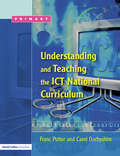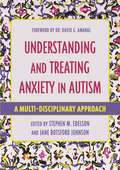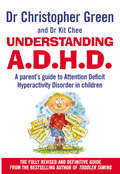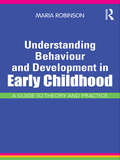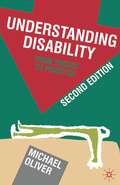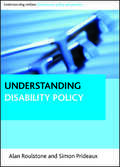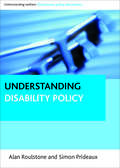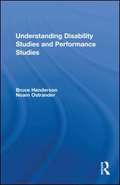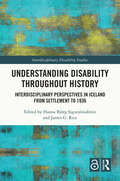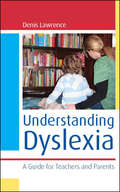- Table View
- List View
Understanding and Teaching the ICT National Curriculum
by Franc PotterThere is still great uncertainty in the teaching profession regarding the effective delivery of ICT. This introductory book provides both trainee and practising teachers with a clear understanding of the ICT National Curriculum and how to teach it. Combining extensive practical advice with a critical discussion of the key theoretical issues, the book will help teachers develop their pupil's true ICT capability through clear explanations of the Programmes of Study, full guidance on using QCA Scheme of Work, different and creative ideas for delivering the ICT National Curriculum, and the confidence and ability to go beyond the QCA Sceme of Work for ICT.
Understanding and Teaching the ICT National Curriculum
by Franc PotterThere is still great uncertainty in the teaching profession regarding the effective delivery of ICT. This introductory book provides both trainee and practising teachers with a clear understanding of the ICT National Curriculum and how to teach it. Combining extensive practical advice with a critical discussion of the key theoretical issues, the book will help teachers develop their pupil's true ICT capability through clear explanations of the Programmes of Study, full guidance on using QCA Scheme of Work, different and creative ideas for delivering the ICT National Curriculum, and the confidence and ability to go beyond the QCA Sceme of Work for ICT.
Understanding and Treating Anxiety in Autism: A Multi-Disciplinary Approach (Understanding and Treating in Autism)
by Brad Ferguson Temple Grandin Karen Margolis Lucy Jane Miller Emily L. Casanova Leslie Weidenman Lauren J. Moskowitz Manuel Casanova Robert Hendren Estate Sokhadze Eva Lamina Desmond Kelly Judy Van de Water Micaela Edelson David Beversdorf Kimberly Law Kelly McCracken Barnhill Virginia Spielmann Margaret Bauman Tomoya Hirtoa Jordan Brooks June Grodin Cooper WoodwardAnxiety is a prevalent and often debilitating condition for individuals on the autism spectrum. This book promotes a multidisciplinary approach to intervention and treatment of the condition, providing professional understanding of the underlying causes and available treatments. With chapters co-authored by well-known advocates and pioneering researchers, contributors examine factors including sensory processing issues, sleep impairments and the crossover between the autonomic nervous system and immune system. The book expands upon current areas of research, including immune activation and the role of environmental toxicants, dietary and nutritional support, the treatment of gastrointestinal disorders and individualised methods of managing stress and anxiety. Providing an invaluable resource for professionals and academics seeking further insight into anxiety and autism, this book explores contemporary research and sets the groundwork for the most effective methods of treatment for individuals of all ages.
Understanding and Treating Self-Injurious Behavior in Autism: A Multi-Disciplinary Perspective (Understanding and Treating in Autism)
by John Green Nancy O'Hara Lucy Jane Miller Margaret L. Bauman V. Mark Durand June Groden Cooper R. Woodard Harumi Jyonouchi Paul Millard Hardy Mary Coleman Emily L. Casanova Karen Misher Leslie Weidenman Lauren J. Moskowitz Jamie D. Bleiweiss Alexis B. Ritter Caitlin E. Walsh Manuel Casanova Kelly McCracken BarnhillA complete guide for parents and practitioners on understanding and treating self-injury in autism (ASD). With contributions by top experts, the book explains various forms of self-injury, discusses the treatment options available, including medical, psychiatric and nutritional treatments, and considers the effectiveness of integrated approaches.
Understanding Anxiety at School: From Personal Experience to Practical Pupil Support
by Rachel ThynneAn increasing number of children face feelings of anxiety and isolation, negatively impacting their mental health and wellbeing, as well as their attainment in school. Having battled social anxiety herself, Rachel Thynne knows first-hand how hard it can be to be misunderstood and receive little help. By understanding the communicative function of behaviours and seeing the person behind their actions, staff can learn to support and nurture pupils with consistency, empathy and positivity.This book explores anxiety in children and young people, unpicking social anxiety, situational mutism, school anxiety and separation anxiety within a school context, and shining a light on the importance of relationships, effective communication and self-regulation skills. A wealth of strength-based strategies are provided that can be implemented quickly and easily by busy school staff to alleviate anxiety, build self-esteem and increase feelings of safety and belonging. The book also supports sensitive and collaborative work with caregivers to achieve the biggest impact and includes real-life examples, case-studies and reflective opportunities to bring theory to life.Little adjustments can make a huge difference and have a positive, lifelong effect on the individual but also on the other pupils. Advocating for whole school approaches to create a culture where all pupils can thrive, Understanding Anxiety at School will enable school staff, including teachers and special educational needs coordinators (SENCOs), to recognise signs of anxiety and to provide support empathically and compassionately.
Understanding Anxiety at School: From Personal Experience to Practical Pupil Support
by Rachel ThynneAn increasing number of children face feelings of anxiety and isolation, negatively impacting their mental health and wellbeing, as well as their attainment in school. Having battled social anxiety herself, Rachel Thynne knows first-hand how hard it can be to be misunderstood and receive little help. By understanding the communicative function of behaviours and seeing the person behind their actions, staff can learn to support and nurture pupils with consistency, empathy and positivity.This book explores anxiety in children and young people, unpicking social anxiety, situational mutism, school anxiety and separation anxiety within a school context, and shining a light on the importance of relationships, effective communication and self-regulation skills. A wealth of strength-based strategies are provided that can be implemented quickly and easily by busy school staff to alleviate anxiety, build self-esteem and increase feelings of safety and belonging. The book also supports sensitive and collaborative work with caregivers to achieve the biggest impact and includes real-life examples, case-studies and reflective opportunities to bring theory to life.Little adjustments can make a huge difference and have a positive, lifelong effect on the individual but also on the other pupils. Advocating for whole school approaches to create a culture where all pupils can thrive, Understanding Anxiety at School will enable school staff, including teachers and special educational needs coordinators (SENCOs), to recognise signs of anxiety and to provide support empathically and compassionately.
Understanding Applied Behavior Analysis, Second Edition: An Introduction to ABA for Parents, Teachers, and other Professionals
by Albert J. KearneyThis introductory guide to ABA demystifies the often complex terminology, the underlying principles, and commonly-used procedures of ABA using accessible, everyday language.This revised and updated edition reflects recent developments and introduces new key terms. Albert J. Kearney explains the kinds of learning and reinforcement processes that form the basis of ABA programs. Having covered these essential principles, he describes how the science of behavior analysis can be effectively applied to real life behavior problems. He looks at how behavior is assessed and various intervention techniques that are often employed with children who have autism and other special needs. Having laid these essential foundations, Kearney touches on more advanced topics: the applications of ABA in behavioral education, such as precision teaching and programmed instruction.
Understanding Attention Deficit Disorder: A Parent's Guide To Attention Deficit Hyperactivity Disorder In Children
by Dr Christopher Green Dr Kit CheeIn his typically friendly and clear style, the ever-popular Dr Chris Green, with Dr Kit Chee, explains the treatments and causes of Attention Deficit Disorder, a condition that affects the learning and behaviour of up to 1 in 10 children in this country. Aimed at parents, teachers and health professionals, this book dispels the myths about ADHD and gives a clear overview of the condition: the causes, the behaviours and the treatments. Full of well-tried, practical strategies to help with common problems such as inattention, underachievement and impulsiveness, the book covers:- The causes, how to help improve behaviour at home and at school- Making the diagnosis, medication and alternative therapies- Hints to help reading, writing and language- Ways to boost self-esteem- ADHD in adults- The latest research and where to go for further helpUnderstanding ADHD offers invaluable guidance to help parents work with teachers and health professionals to give their child the best possible chance of entering adulthood with self-confidence, life skills and secure family relationships.
Understanding Autism and Autistic Functioning: A Guide for Parents, Educators and Professionals (Understanding Atypical Development)
by Laura Villa Luca CasartelliThis concise volume offers an accessible overview of recent clinical and research perspectives addressing autism and autistic functioning. By providing an innovative lens, the book benefits from two different angles: a concrete and pragmatical view of an expert clinician with three decades of practice in diagnosis and treatment of autism, and a more “speculative” and “long-term” view of a researcher who works on neural and computational architecture of (a)typical neurocognitive functioning.Trying to understand autism beyond its behavioral symptoms, the book spans from clinical descriptions (e.g., communicating diagnosis, clinical intervention, and prognosis) to recent neuroscientific evidence supporting a potential perspective-shift. The fil rouge of this volume can be summarized in three fundamental aspects that should orient any clinical practice in the context of autism (e.g., diagnosis, treatment, monitoring, etc.): we need an age-dependent, context-dependent, and functioning-dependent approach.Understanding Autism and Autistic Functioning is crucial reading for parents and caregivers, and professionals in health, education, and social care.
Understanding Autism and Autistic Functioning: A Guide for Parents, Educators and Professionals (Understanding Atypical Development)
by Laura Villa Luca CasartelliThis concise volume offers an accessible overview of recent clinical and research perspectives addressing autism and autistic functioning. By providing an innovative lens, the book benefits from two different angles: a concrete and pragmatical view of an expert clinician with three decades of practice in diagnosis and treatment of autism, and a more “speculative” and “long-term” view of a researcher who works on neural and computational architecture of (a)typical neurocognitive functioning.Trying to understand autism beyond its behavioral symptoms, the book spans from clinical descriptions (e.g., communicating diagnosis, clinical intervention, and prognosis) to recent neuroscientific evidence supporting a potential perspective-shift. The fil rouge of this volume can be summarized in three fundamental aspects that should orient any clinical practice in the context of autism (e.g., diagnosis, treatment, monitoring, etc.): we need an age-dependent, context-dependent, and functioning-dependent approach.Understanding Autism and Autistic Functioning is crucial reading for parents and caregivers, and professionals in health, education, and social care.
Understanding Autism For Dummies
by Stephen Shore Linda G. RastelliAutism affects more than 1 million children and adults in the United States, and parents may be confused by the behavior of autistic children. This book provides help-and hope-by explaining the differences between various types of autism and delivering the lowdown on behavioral, educational, medical, other interventions. Featuring inspiring autism success stories as well as a list of organizations where people who support those with autism can go for additional help, it offers practical advice on how to educate children as well as insights on helping people with autism use their strengths to maximize their potential in life. Stephen Shore, EdD (Brookline MA), serves on the board for several autism spectrum-related organizations and he has written Beyond the Wall: Personal Experiences with Autism and Asperger Syndrome (1-931282-00-5) and edited Ask and Tell: Self Advocacy and Disclosure For People on the Autism Spectrum (1-931282-58-7). Linda G. Rastelli (Middletown, NJ) is a veteran journalist who specializes in health and business. Temple Grandin, PhD (Fort Collins, CO) is the author of the bestselling Thinking in Pictures (0-679-77289-8) and Emergence: Labeled Autistic (0-446-67182-7).
Understanding Autism For Dummies
by Stephen Shore Linda G. RastelliAutism affects more than 1 million children and adults in the United States, and parents may be confused by the behavior of autistic children. This book provides help-and hope-by explaining the differences between various types of autism and delivering the lowdown on behavioral, educational, medical, other interventions. Featuring inspiring autism success stories as well as a list of organizations where people who support those with autism can go for additional help, it offers practical advice on how to educate children as well as insights on helping people with autism use their strengths to maximize their potential in life. Stephen Shore, EdD (Brookline MA), serves on the board for several autism spectrum-related organizations and he has written Beyond the Wall: Personal Experiences with Autism and Asperger Syndrome (1-931282-00-5) and edited Ask and Tell: Self Advocacy and Disclosure For People on the Autism Spectrum (1-931282-58-7). Linda G. Rastelli (Middletown, NJ) is a veteran journalist who specializes in health and business. Temple Grandin, PhD (Fort Collins, CO) is the author of the bestselling Thinking in Pictures (0-679-77289-8) and Emergence: Labeled Autistic (0-446-67182-7).
Understanding Behaviour and Development in Early Childhood: A Guide to Theory and Practice
by Maria RobinsonIn this accessible and thought-provoking text, the author examines the behaviour of babies and young children in a developmental context, and takes into account the shifts and changes over time as young children grow and mature. Understanding Behaviour and Development in Early Childhood reveals, for example, how behaviour perceived as ‘difficult’ in a young child may be the manifestation of a response to emotional, sensory and cognitive experiences. Throughout the book, readers will find a strong emphasis on emotional well-being and the need to place our understanding of behaviour within a developmental time frame. Based on wide ranging professional experience the topics examined and discussed in this insightful book include: what we understand by ‘behaviour’ how the brain and senses work and mature during early childhood behaviour as a reflection of the child’s internal state what emotions are and how we learn what feelings mean to us as individuals how emotions affect our ability to learn how we develop a sense of self. The book provides suggestions for how adults may think about and respond to changes in children’s behaviour, and how we may support children in learning how to manage their own behaviour as they grow older and encounter wider and more complex situations. Understanding the meaning of behaviour is a constant challenge for anyone working with children. This developmental approach promotes a helpful reflective stance for practitioners and students working in early childhood education and care.
Understanding Behaviour and Development in Early Childhood: A Guide to Theory and Practice
by Maria RobinsonIn this accessible and thought-provoking text, the author examines the behaviour of babies and young children in a developmental context, and takes into account the shifts and changes over time as young children grow and mature. Understanding Behaviour and Development in Early Childhood reveals, for example, how behaviour perceived as ‘difficult’ in a young child may be the manifestation of a response to emotional, sensory and cognitive experiences. Throughout the book, readers will find a strong emphasis on emotional well-being and the need to place our understanding of behaviour within a developmental time frame. Based on wide ranging professional experience the topics examined and discussed in this insightful book include: what we understand by ‘behaviour’ how the brain and senses work and mature during early childhood behaviour as a reflection of the child’s internal state what emotions are and how we learn what feelings mean to us as individuals how emotions affect our ability to learn how we develop a sense of self. The book provides suggestions for how adults may think about and respond to changes in children’s behaviour, and how we may support children in learning how to manage their own behaviour as they grow older and encounter wider and more complex situations. Understanding the meaning of behaviour is a constant challenge for anyone working with children. This developmental approach promotes a helpful reflective stance for practitioners and students working in early childhood education and care.
Understanding Cerebral Palsy: A Guide for Parents and Professionals (JKP Essentials)
by Marion StantonA great starting point for parents and professionals when they first encounter cerebral palsy, this book provides essential information on causes, types, symptoms and treatments as well as practical tips on everyday considerations such as communication and diet. This positive handbook will help readers more fully understand cerebral palsy.
Understanding Controversial Therapies for Children with Autism, Attention Deficit Disorder, and Other Learning Disabilities: A Guide to Complementary and Alternative Medicine (JKP Essentials)
by Elizabeth A KurtzOffering a balanced overview of complementary and alternative therapies, this book will be useful for parents of children with autism, ADD or other learning disabilities. The book covers a wide variety of mind-body interventions and manipulative techniques, as well as energy therapies, biologically based methods, and alternative medical systems.
Understanding Disability: From Theory to Practice
by Michael OliverIn this absorbing text by a leading writer and respected activist, theory, policy, historical background and personal experience are combined to give readers a rich and illuminating picture of the key issues raised by disability. In the author's uniquely clear and lively narrative style, the book explores:the practical and political challenges that disablement presentstheoretical understandings of disabilitydisability law and the realities of policy implementationkey points of contention for the disability movementThis long-awaited new edition of a best-selling text includes new stories from the author's experience, as well as sharply framed debate aboutthe development of policy over the last decade and a half. Its expansive coverage includes discussion of welfare, rehabilitation, special education and normalization. This book is core reading for students of social work, nursing, health and applied social science taking modules in disability studies. Michael Oliver was the first Professor of Disability Studies in the United Kingdom and is Emeritus Professor of Disability Studies at the University of Greenwich, UK. He is the author of the path-breaking The Politics of Disablement and Social Work with Disabled People (in its third edition, co-authored with Bob Sapey).
Understanding disability policy (Understanding Welfare: Social Issues, Policy and Practice series)
by Alan Roulstone Simon PrideauxIn an era of scarce social resources the question of the changing social policy constructions and responses to disabled people has become increasingly important. Paradoxically, some disabled people are realising new freedoms and choices never before envisioned, whilst others are prey to major retractions in public services and aggressive attempts to redefine who counts as 'genuinely disabled'. Understanding disability policy locates disability policy into broader social policy and welfare policy writings and goes beyond narrow statutory evaluations of welfare to embrace a range of indicators of disabled people's welfare. The book critically explores the roles of social security, social support, poverty, socio-economic status, community safety, official discourses and spatial change in shaping disabled people's opportunities. It also situates welfare and disability policy in the broader conceptual shifts to the social model of disability and its critics. Finally it explores the possible connection between changing official and academic constructions of disability and their implications for social policy in the 21st century. The book is supported by a companion website, containing additional materials for both students and lecturers using the book, which is available from the link above.
Understanding disability policy (Understanding Welfare: Social Issues, Policy and Practice series)
by Alan Roulstone Simon PrideauxIn an era of scarce social resources the question of the changing social policy constructions and responses to disabled people has become increasingly important. Paradoxically, some disabled people are realising new freedoms and choices never before envisioned, whilst others are prey to major retractions in public services and aggressive attempts to redefine who counts as 'genuinely disabled'. Understanding disability policy locates disability policy into broader social policy and welfare policy writings and goes beyond narrow statutory evaluations of welfare to embrace a range of indicators of disabled people's welfare. The book critically explores the roles of social security, social support, poverty, socio-economic status, community safety, official discourses and spatial change in shaping disabled people's opportunities. It also situates welfare and disability policy in the broader conceptual shifts to the social model of disability and its critics. Finally it explores the possible connection between changing official and academic constructions of disability and their implications for social policy in the 21st century. The book is supported by a companion website, containing additional materials for both students and lecturers using the book, which is available from the link above.
Understanding Disability Studies And Performance Studies (PDF)
by Bruce B. Henderson Noam OstranderThis collection brings together scholarship and creative writing that brings together two of the most innovative fields to emerge from critical and cultural studies in the past few decades: Disability studies and performance studies. It draws on writings about such media as live performance art, photography, silent film, dance, personal narrative and theatre, using such diverse perspectives and methods as queer theory, gender, feminist, and masculinity studies, dance studies, as well as providing first publication of creative writings by award-winning poets and playwrights. This book was based on a special issue of Text and Performance Quarterly.
Understanding Disability Throughout History: Interdisciplinary Perspectives in Iceland from Settlement to 1936 (Interdisciplinary Disability Studies)
by Hanna Björg Sigurjónsdóttir James G. RiceUnderstanding Disability Throughout History explores seldom-heard voices from the past by studying the hidden lives of disabled people before the concept of disability existed culturally, socially and administratively. The book focuses on Iceland from the Age of Settlement, traditionally considered to have taken place from 874 to 930, until the 1936 Law on Social Security (Lög um almannatryggingar), which is the first time that disabled people were referenced in Iceland as a legal or administrative category. Data sources analysed in the project represent a broad range of materials that are not often featured in the study of disability, such as bone collections, medieval literature and census data from the early modern era, archaeological remains, historical archives, folktales and legends, personal narratives and museum displays. The ten chapters include contributions from multidisciplinary team of experts working in the fields of Disability Studies, History, Archaeology, Medieval Icelandic Literature, Folklore and Ethnology, Anthropology, Museum Studies, and Archival Sciences, along with a collection of post-doctoral and graduate students. The volume will be of interest to all scholars and students of disability studies, history, medieval studies, ethnology, folklore, and archaeology.
Understanding Disability Throughout History: Interdisciplinary Perspectives in Iceland from Settlement to 1936 (Interdisciplinary Disability Studies)
by Hanna Björg Sigurjónsdóttir James G. RiceUnderstanding Disability Throughout History explores seldom-heard voices from the past by studying the hidden lives of disabled people before the concept of disability existed culturally, socially and administratively. The book focuses on Iceland from the Age of Settlement, traditionally considered to have taken place from 874 to 930, until the 1936 Law on Social Security (Lög um almannatryggingar), which is the first time that disabled people were referenced in Iceland as a legal or administrative category. Data sources analysed in the project represent a broad range of materials that are not often featured in the study of disability, such as bone collections, medieval literature and census data from the early modern era, archaeological remains, historical archives, folktales and legends, personal narratives and museum displays. The ten chapters include contributions from multidisciplinary team of experts working in the fields of Disability Studies, History, Archaeology, Medieval Icelandic Literature, Folklore and Ethnology, Anthropology, Museum Studies, and Archival Sciences, along with a collection of post-doctoral and graduate students. The volume will be of interest to all scholars and students of disability studies, history, medieval studies, ethnology, folklore, and archaeology.
Understanding Dyscalculia and Numeracy Difficulties: A Guide for Parents, Teachers and Other Professionals
by Patricia Babtie Jane EmersonDyscalculia is a specific learning difficulty that affects the acquisition of numerical skills. A far larger number of pupils, while not dyscalculic, fail to acquire the basic numerical skills required for everyday life. Whatever the cause of poor numeracy it is essential that these difficulties are identified and addressed. This book looks at how adults can help identify each child's specific areas of difficulty and describes a multi-sensory approach that can be adapted for the needs of each student to help them better understand numbers and apply that understanding to solve problems. It covers the origins of number sense and how the brain deals with numbers, assessment, planning intervention, what to teach and how to teach it, and how parents can help their children. This straightforward guide will be essential reading for any parent, teacher or education professional working with a child with dyscalculia or numeracy difficulties.
Understanding Dyscalculia and Numeracy Difficulties: A Guide for Parents, Teachers and Other Professionals (PDF)
by Jane Emerson Patricia BabtieDyscalculia is a specific learning difficulty that affects the acquisition of numerical skills. A far larger number of pupils, while not dyscalculic, fail to acquire the basic numerical skills required for everyday life. Whatever the cause of poor numeracy it is essential that these difficulties are identified and addressed. This book looks at how adults can help identify each child's specific areas of difficulty and describes a multi-sensory approach that can be adapted for the needs of each student to help them better understand numbers and apply that understanding to solve problems. It covers the origins of number sense and how the brain deals with numbers, assessment, planning intervention, what to teach and how to teach it, and how parents can help their children. This straightforward guide will be essential reading for any parent, teacher or education professional working with a child with dyscalculia or numeracy difficulties.
Understanding Dyslexia: A Guide For Teachers And Parents (UK Higher Education OUP Humanities & Social Sciences Education OUP)
by Denis Lawrence"In his book Understanding Dyslexia Denis Lawrence leaves no stone unturned. This up-to-date book provides a comprehensive account of all aspects of dyslexia. The author's knowledge, experience and empathy is evident and the book can be recommended for all who want a simple account of the nature and consequences of dyslexia."Professor Maggie Snowling, University of York, UK"[This book is] a very readable introduction and guide covering theories of dyslexia and important areas of practical importance to those living with dyslexia or providing support for them."J.B.Thomas, Loughborough University, UKDyslexia affects at least ten per cent of children and is the most common special educational need that teachers encounter. However, the characteristics of dyslexia can mean that it is often confused with other learning difficulties. Whether you are a teacher or a parent, this easy-to-read book helps you to understand what is meant by 'dyslexia', providing clear guidance for identifying the signs and outlining practical strategies for helping and supporting dyslexic children. As well as examining current popular definitions of dyslexia, the book offers a fresh definition, based on current research. Each chapter helps you to understand the unique challenges faced by dyslexic children in their learning of literacy skills and shows that the combined efforts of parents and teachers really can make a difference.Key features include: Coverage of the most popular methods used in the assessment of dyslexia Strategies and techniques to help dyslexic children develop their literacy skills at school and at home A focus on how to enhance and maintain self-esteem in dyslexic children A look at other specific learning difficulties that overlap or can be confused with dyslexia Discussion of society's attitude towards dyslexia and the need for further understanding of the conceptUnderstanding Dyslexia is valuable reading for trainee and practising teachers, SENCOs and parents.
